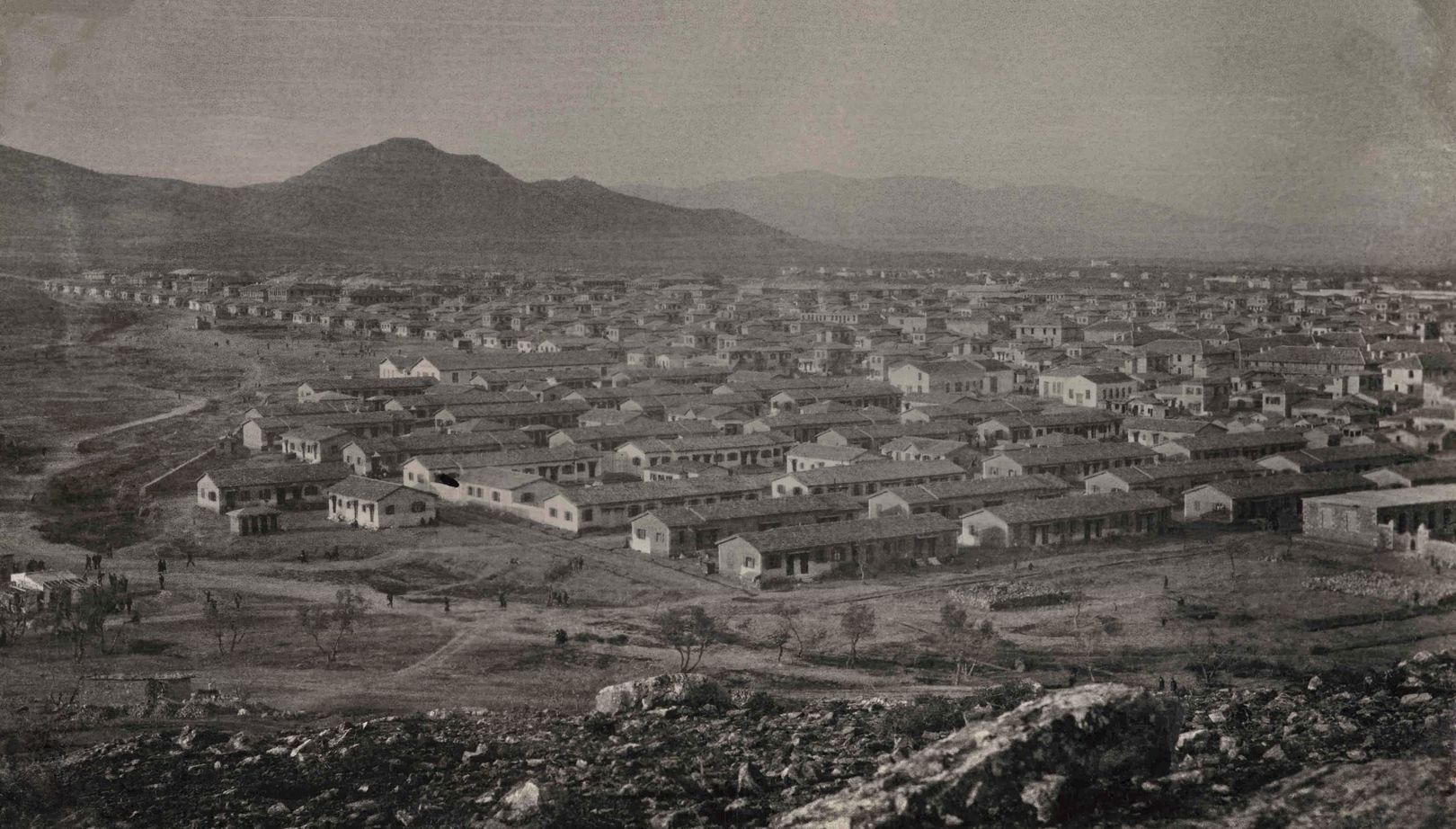Refugee Houses, Residential Blocks and Communal Spaces in Nikaia
City
Migration Period
City Narratives
Tag
Category
Full Description
The refugee houses of Nikaia
Nikaia was one of the twelve largest urban refugee settlements. Its development started in June 1923 by the Refugee Relief Fund (Papaioannou and Vasilikioti 1975; Lamprou and Mourgou 2020). The original settlement was erected along the stream (Lamprou, Mourgou, and Veranis 2017), in the vicinity of today’s Tzavela/Belogianni Street. In 1924, the Refugee Settlement Commission expropriated the area north of the stream, officially established ‘Nea Kokkinia’, and implemented an extensive urban development plan (Lamprou and Mourgou 2020). This plan has left indelible marks on the area that are visible to this day. A large number of refugee houses is still standing, some almost intact, others bearing the signs of various changes, attributed to a series of additions and transformations by their owners or simply caused by neglect.
The typologies of the area’s refugee houses which are presented below are based on a review of the literature (Lavrentiadou and Athanasopoulou 2015; Papaioannou and Vasilikioti 1975; Tousi 2014), the examination of old land registry maps (Nea Kokkinia Land Survey. Sheets I-XII, 1931), as well as the cross-referencing of this data with on-site investigation (Katrini 2022).
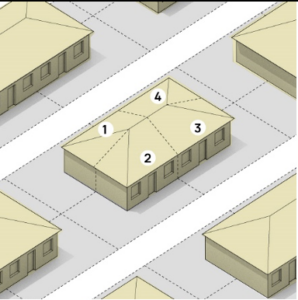 |
Type 1: Single story fourplex
Average house surface area: ~23 m2
These residential units were the ones built first by the Refugee Relief Fund in the area between Tzavela/Belogianni Street and the south part of the Agios Nikolaos Square. The rectangular building is divided vertically and horizontally creating four dwellings, each about 23 square metres large. The building had no toilets. The initial plan included a communal space and communal lavatories in between the rows of houses, but in the end these were not constructed.
|
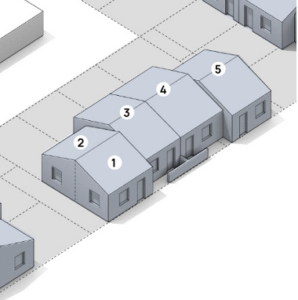 |
Type 2a-b-c: Single story row houses
Average house surface area: ~30 m2
Ground floor buildings measuring about 30 square metres erected by the Refugee Settlement Commission in a row of 4 (2a) or 6-8 units (2b). The middle units are slightly set back to create a small front yard/entrance. In some cases there is no setback and the units are simply arranged in a row (2c). Each house is built out of unburnt clay bricks and has a tiled roof. It has a main space, a kitchen and a WC. In some cases, the end units are divided into two dwellings, creating a complex of six or eight houses (without a WC).
|
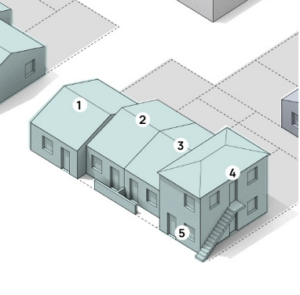 |
Type 3: 3 one-story singles and 1 two-story duplex
Average house surface area: ~30 m2
Housing complex built by the Refugee Settlement Commission made up of five dwellings, four on the ground floor and one on the first floor. Each dwelling has one main space, one auxiliary space and a WC. Essentially, this complex resembles type 2α but one of the end units has two stories and houses two families. The two-story unit is always situated in the corner of the residential block. The ground floor is made of stone while the story is made of bricks.
|
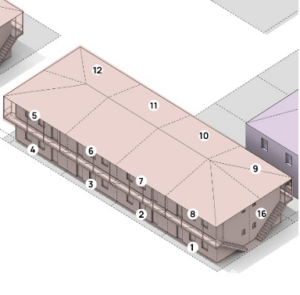 |
Type 4: Apartment block – complex with 16, 12 or 8 residential units
Average house surface area: ~35 m2
At the end of the 1920s and the beginning of the 1930s, the Refugee Settlement Commission started building a few apartment blocks in the area. These characteristic, rectangular, two-story buildings were erected in Nikaia, housing multiple residential units arranged in rows opposite each other on each floor. The units on the long sides have their own entrances. Access to the upper stories is possible via criss-crossing exterior staircases on the short sides of the building leading to (originally) wooden corridors. The building’s slabs are made of reinforced concrete, the walls are usually stone and the roof is tiled.
|
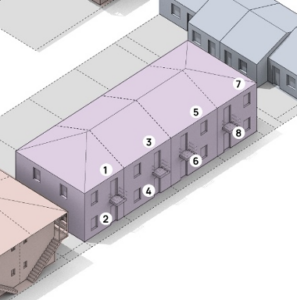 |
Type 5: Two-story duplexes in rows of 2 or 4
Average house surface area: ~35 m2
A common typology used by the Refugee Settlement Commission were these twin two-story houses, accommodating two families each, one on the ground floor and one on the first floor. These duplexes are similar to the British rowhouses/terraced houses and in Nikaia they usually come in rows of 2 or 4 (namely 4 or 8 residential units in total). They have a tile roof and walls made of stone or large burnt clay bricks. The upstairs and the downstairs units share a common entrance. |
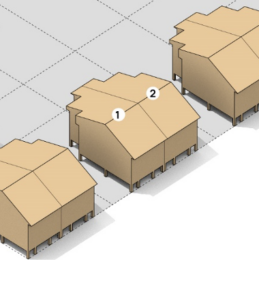 |
Type 6: ‘Germanika’, prefabricated houses
Average house surface area: ~38 m2
The Urban Refugee Settlement Management Service was established in 1927 in order to complete the unfinished work of the Refugee Relief Fund. The Service also undertook the development of more refugee housing clusters, including ‘Germanika’ [The German houses] in Kokkinia (Leontidou-Emmanouil 2001). ‘Germanika’ are concentrated within approximately 35 residential blocks between Agios Georgios Square and today’s Dimokratia Square. They are prefabricated wooden dwellings with the floor slightly raised from the ground. In almost all cases, the ground was later dug out to create a basement (Hirschon 1989). They are called ‘Germanika’ because they were funded by Germany as a form of economic reparation for the First World War. Each unit is approximately 8,5 metres by 9 metres, providing two rooms, a kitchen and a WC.
|
Map of remaining refugee houses (2022)
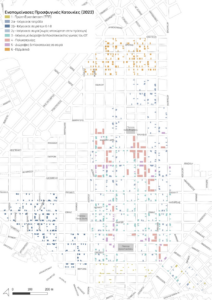
Typologies of the refugee residential blocks in Nikaia
The aforementioned typologies of residential units are arranged in blocks in various ways, creating a series of private, communal, public and semi-public spaces. In addition, the appropriation of the space by its residents caused successive spatial transformations, creating over the years a complex urban environment which is a far cry from the Commission’s original development plan. According to this plan, there were six main block typologies, based on the land registry maps of 1931. In the diagrams that follow, the boundaries of the private land plots on which the residential units were built are represented with dotted lines and the plots are marked in grey.
| Type Α: Long rectangular blocks
Dimensions: 50m x 15m or 30m x 10m
Long rectangular blocks with type 1 residential units can only be found in the area of Tzavella/Belogianni street and south of the Agios Nikolaos Square. The fourplexes are placed on the plots in a way that usually allows for some kind of private front or side yard, although not all dwellings had yards. Today these blocks are characterised by intense development. Three or four such refugee residential blocks are now recognised as a single block, as most of the streets between them have become pedestrian streets. In some cases, these pedestrian streets function as parking spaces while, in others, they are used as entrances, decorated by the residents with chairs and potted plants and treated as an extension of their house.
|
|
| Type Β1: Residential blocks with communal space and 1 alley
Dimensions: 45m x 50-60m
Square or rectangular blocks on the perimeter of which are arranged single story residential units (type 2a-b-c) in a way that allows for open communal areas in the interior of the block. These communal spaces were accessed through an alley at the centre of the block. In the larger blocks, there were also two narrower passages perpendicular to the alley, most of which have now been closed off. The communal spaces housed shared laundry rooms and lavatories which were later torn down. This typology is most common in the area of Kilikiana. In the mid-1980s, when the area’s central sewage system was completed, the septic tanks that used to be situated in the communal spaces were filled with rubble and used for planting. Apart from the communal spaces, there were also open spaces used as private yards which face the inside of the block, since the placement of the buildings did not entirely cover the land plots. In most cases, the open spaces of these plots have now been covered either by extensions and additions or by new structures which utilise the entirety of the plot. |
|
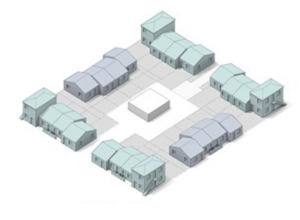 |
Type Β2: Residential blocks with communal space and 1 alley Dimensions: 45×50-60m
Square or rectangular residential blocks similar in arrangement to type B1. They have communal spaces in the interior with an alley down the middle and two narrow entrances (for the larger blocks). Its main difference with type B1 is that this block accommodates type 2 and 3 residential units in an arrangement that places the two-story buildings in the corners. This typology appears mostly between Agios Nikolaos and Agios Georgios and many of the corner, two-story buildings survive to this day, even if transformed through additions or extensions.
|
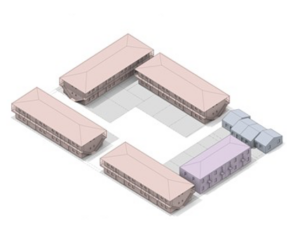 |
Type C: Residential blocks with communal space and alleys
Dimensions: 50m x70m
Large blocks with communal spaces for laundry rooms, similar to typology B, but including multiple alleys. In these blocks, we encounter a combination of single-story and two-story residential units, including the typical Nikaia apartment complexes (type 4). These blocks can mainly be found in the area of Agios Georgios, but some are also located in the area south east of Agios Nikolaos. However, none of these blocks appears to consist exclusively of type 4 apartment complexes.
|
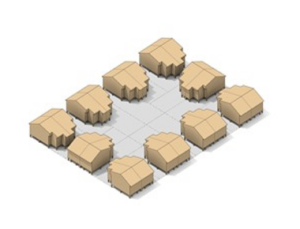 |
Type D: ‘Germanika’ Residential Block
Dimensions: 50m x 35m
The blocks of the ‘Germanika’ settlement (type 6), which were vividly described in the works of Renée Hirschon, are located north of the Agios Georgios area and south of today’s Dimokratia Square. These blocks aresmaller and were divided into 20 land plots on which the prefabricated houses were placed. The division of the land into plots allows for private open spaces/yards facing the middle of the block. However, the corner properties are markedly smaller and do not have a yard, which Hirschon herself recognised as problematic. These blocks do not have communal spaces and nowadays even the open spaces on each property have been almost completely covered. Some of the prefabricated houses still stand.
|
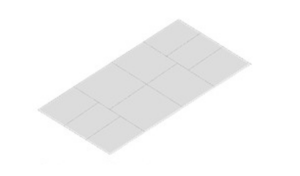 |
Type Ε: Plots and Self-housing
Various dimensions
Several residential blocks in the historic centre of Nikaia appear to have been divided and granted to refugees for self-housing. In these cases, the blocks were not designed according to a specific plan and have now been intensively developed.
|
Map of the Open Communal Spaces of Nikaia (2022)
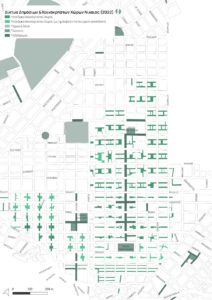
Based on the block typologies presented above, which were stipulated by the Refugee Settlement Commission’s development plan, it becomes clear that since its inception, Nikaia’s historic centre has had an abundance of open communal spaces in addition to the area’s wider public space network (squares, pedestrian streets, etc.). Naturally, many of these spaces have changed in the course of time due to the various transformations the blocks have undergone, such as expropriations, additions, demolitions and constructions of new buildings, development of what used to be laundry rooms at the centre of the communal space, land merging, and changes in the area’s floor area ratio and building coverage ratio (Lavrentiadou and Athanasopoulou 2015).
Despite these transformations, today there are 134 residential blocks at the centre of Nikaia which still have some type of a communal open space in their interior. Of these, 62 have a communal courtyard while the other 72 have pedestrianised alleys or an alley network. In 2018, the Municipality implemented a regeneration scheme for the communal courtyards of five residential blocks in the area of Kilikiana and, in 2021, it started renewing the paving stones and flower beds in another 23 communal spaces.
Bibliography
Eleni Katrini, ‘Mapping the remaining refugee houses in the historic centre of Nikaia’, part of the research project Places of Togetherness, School of Architecture, National Technical University of Athens, Athens 2022.
Nea Kokkinia Land Registry. Sheets I-XII, Refugee Settlement Commission, Athens 1931. Located in the Municipality of Nikaia-Agios I. Rentis
Anna Lamprou and Alexandra Mourgou, ‘Nea Kokkinia: exploring the multiple identities of a refugee area during the Interwar’,Geographies [biannual publication], no. 35, pp. 146-155.
Anna Lamprou, Alexandra Mourgou and Giorgos Veranis, ‘Refugee Piraeus: Registry of refugee houses in Nikaia’, 2017. http://prosfigikospireas.blogspot.com/2017/06/blog-post.html
M.B. Lavrentiadou and N.A. Athanasopoulou, ‘The case of communal spaces in the refugee residential blocks (Kikiliana) of Nikaia’, Athens 2015. https://docplayer.gr/99527-I-periptosi-ton-koinohriston-horon-ton-prosfygikon-tetragonon-kilikiana-stin-poli-tis-nikaias.html
Lila Leontidou-Emmanouil, Cities of silence: workers’ settlements in Athens and Piraeus 1909 – 1940, 2nd edition, ETVA Cultural Foundation, Athens 2001.
I. Papaioannou and E. Vasilikioti, Housing in Greece. State interventions, eds. V. Ampadogianni and O. Zaverdinou, Technical Chamber of Greece, Athens 1975.
Evgenia Tousi, The urban space as a field of socio-spatial transformations in the light of the refugee issue: the case of the urban conglomeration of Athens – Piraeus, doctoral thesis, School of Architecture, National Technical University of Athens, Athens 2014. http://hdl.handle.net/10442/hedi/42796
Renee Hirschon, Heirs of the Greek catastrophe: the social life of Asia Minor refugees in Piraeus, Berghahn Books, Oxford 1998.
